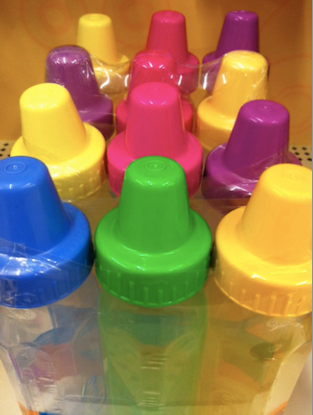Tips on formula feeding
 Many families know from the start they plan to formula feed their babies. For some, this decision is based on the mom’s medical condition which precludes breastfeeding. Some base the decision on cultural beliefs, some on personal preference. Still others have tried to breast feed but nursing does not work out.
Many families know from the start they plan to formula feed their babies. For some, this decision is based on the mom’s medical condition which precludes breastfeeding. Some base the decision on cultural beliefs, some on personal preference. Still others have tried to breast feed but nursing does not work out.
Whatever the reason, any maternal guilt over not breastfeeding should be left behind once the decision is made to bottle feed. We point out, “Just think of all of those college graduates who were formula fed as infants!”
Here are some tips for formula feeding:
- Remember that babies may not be equally hungry at all meals. Sometimes newborns are full after drinking just ½ an ounce, other times they may suck down 2-3 ounces.
- Formula takes a little longer to digest than breast milk, so while some formula fed babies eat every two hours, others feed every 3-4 hours.
- You only have to sterilize the bottles the first time you use them. After that, washing them with warm soapy water or putting them in your dishwasher will get them clean enough.
- If using powder formula, you may mix it with tap water to whatever temperature your baby prefers. If you drink tap water, no need to boil the water first for your baby or to buy bottled water or “nursery water” or any other special gimmicky water. For those adults who routinely boil or filter their own drinking water, continue to do the same for your infant.
- When rewarming formula do not put a bottle of formula directly in the microwave Microwaving produces hotspots and most plastic bottles are not microwave safe. The American Academy of Pediatric’s advice is to rewarm a bottle in a bowl of lukewarm water. But, we know in real life, everyone smiles at us and sneaks off to use the microwave. If you must use the microwave, first transfer formula into a microwave safe container, heat for only a few seconds at a time and then mix the formula very, very well and transfer back into a bottle. Before giving the bottle to your baby, test the formula’s temperature on the inside of your wrist. This is all moot if your baby takes formula at room temperature… try room temperature… you never know.
- Let your baby decide when she has had enough to eat. Don’t force her to finish up the last drop—this is the infant equivalent of your insisting on a clean plate. Teach your baby to eat when hungry and stop when she is no longer hungry. Parents have to be okay with “wasting” some formula. Make up more than you think she will need and throw out the rest.
- Standard FDA-approved cow-milk based formula with iron meets most babies’ needs. Some parents have coupons for one brand over another, or prefer to buy the store brand over the name brands. Fine to toggle between brands or types of formulations (eg ready-to-feed vs. powder).
- Do NOT give your infant “low iron” formula, homemade formula, goat milk, or regular cow’s milk. Call your child’s doctor if you are worried that your baby is not tolerating her standard infant formula.
- The American Academy of Pediatrics recommends giving babies formula until one year of age, at which time you can transition your baby to whole cow’s milk. No need to go onto the toddler formulas.
Enjoy feeding your child. Hold her close and allow her to study your face as you feed her. Talk or sing during her meals. Formula and
breast milk have the same calorie count and a similar nutrition content. Love and food can come through a bottle. Ultimately, what works within your family is what is right for your family.
Julie Kardos, MD and Naline Lai, MD
©2012 Two Peds in a Pod®